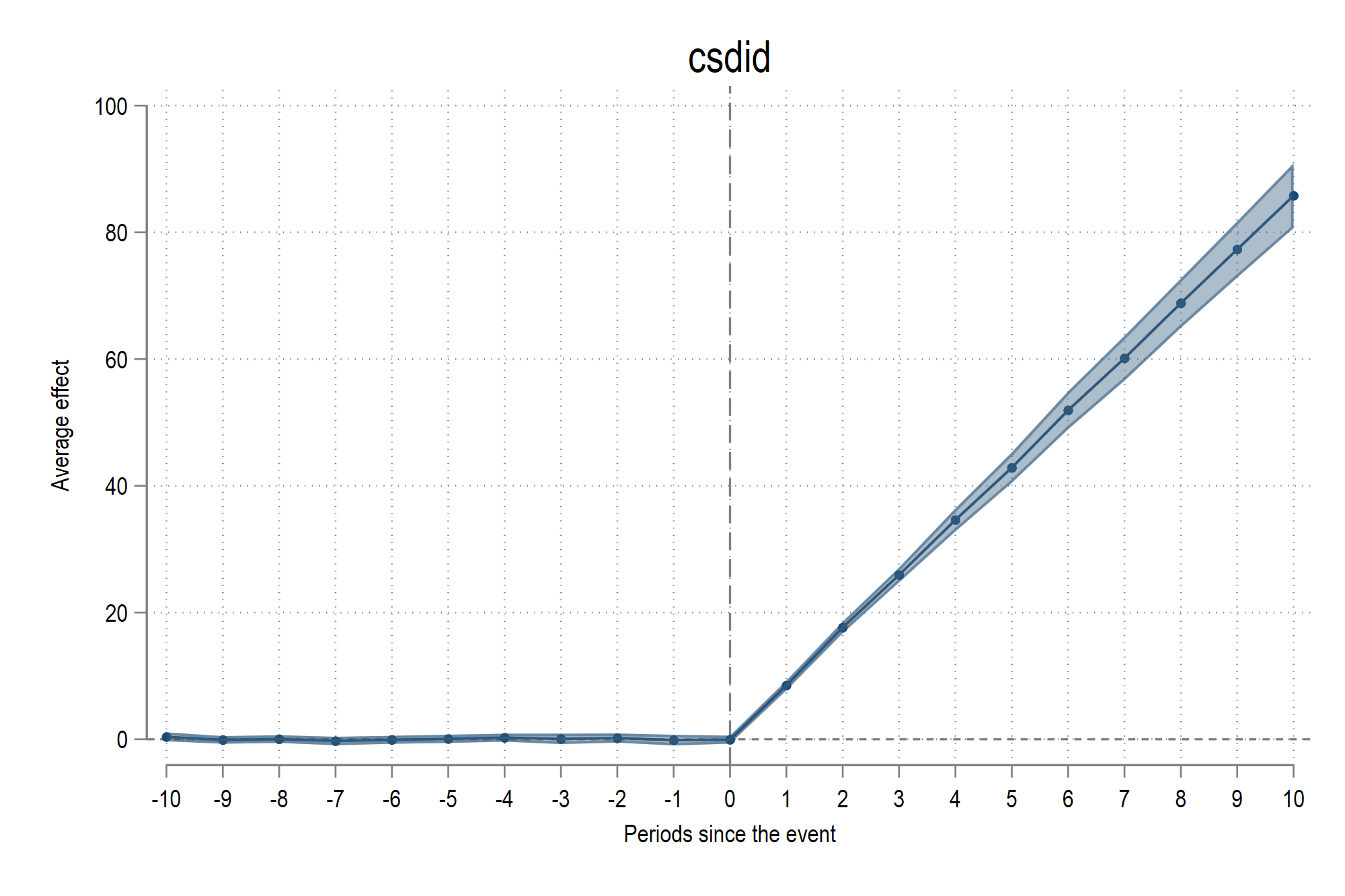csdid
Table of contents
Notes
- Based on: Callaway and Sant’Anna 2021
- Program version (if available): v1.72
- Last checked: Nov 2024
Installation
ssc install csdid, replace
Take a look at the help file:
help csdid
Test the command
Please make sure that you generate the data using the script given here
For csdid we need the gvar variable which equals the first_treat value for the treated, and 0 for the not treated:
gen gvar = first_treat
recode gvar (. = 0)
Let’s try the basic csdid command:
csdid Y, ivar(id) time(t) gvar(gvar) notyet
And a very very long output will show up on the screen (combination explosion)! We can recover an event study with 10 leads and 10 lags as a post-estimation option:
estat event, window(-10 10) estore(cs)
which will show this output:
ATT by Periods Before and After treatment
Event Study:Dynamic effects
------------------------------------------------------------------------------
| Coefficient Std. err. z P>|z| [95% conf. interval]
-------------+----------------------------------------------------------------
Tm10 | .3917418 .3493034 1.12 0.262 -.2928803 1.076364
Tm9 | -.0720548 .2991634 -0.24 0.810 -.6584043 .5142947
Tm8 | .0197712 .3119967 0.06 0.949 -.5917311 .6312735
Tm7 | -.2900224 .346774 -0.84 0.403 -.9696869 .3896422
Tm6 | -.1089479 .3190294 -0.34 0.733 -.734234 .5163383
Tm5 | .092667 .3352292 0.28 0.782 -.5643702 .7497042
Tm4 | .2572878 .3222909 0.80 0.425 -.3743907 .8889663
Tm3 | .0639963 .4214074 0.15 0.879 -.7619471 .8899396
Tm2 | .1944381 .3707239 0.52 0.600 -.5321673 .9210435
Tm1 | -.1308918 .4307277 -0.30 0.761 -.9751027 .713319
Tp0 | -.0608394 .3220462 -0.19 0.850 -.6920383 .5703595
Tp1 | 8.49767 .3964781 21.43 0.000 7.720587 9.274753
Tp2 | 17.64773 .4650298 37.95 0.000 16.73629 18.55917
Tp3 | 25.9377 .5978201 43.39 0.000 24.76599 27.1094
Tp4 | 34.62362 .9250424 37.43 0.000 32.81057 36.43667
Tp5 | 42.85682 1.223002 35.04 0.000 40.45978 45.25386
Tp6 | 51.93103 1.529193 33.96 0.000 48.93387 54.92819
Tp7 | 60.13327 1.804358 33.33 0.000 56.59679 63.66975
Tp8 | 68.82446 1.982765 34.71 0.000 64.93831 72.71061
Tp9 | 77.30792 2.264938 34.13 0.000 72.86872 81.74712
Tp10 | 85.78878 2.61102 32.86 0.000 80.67128 90.90629
------------------------------------------------------------------------------
In order to plot the estimates we can use the event_plot (ssc install event_plot, replace) command as follows:
event_plot cs, default_look graph_opt(xtitle("Periods since the event") ytitle("Average effect") ///
title("csdid") xlabel(-10(1)10)) stub_lag(Tp#) stub_lead(Tm#) together
And we get this figure:
